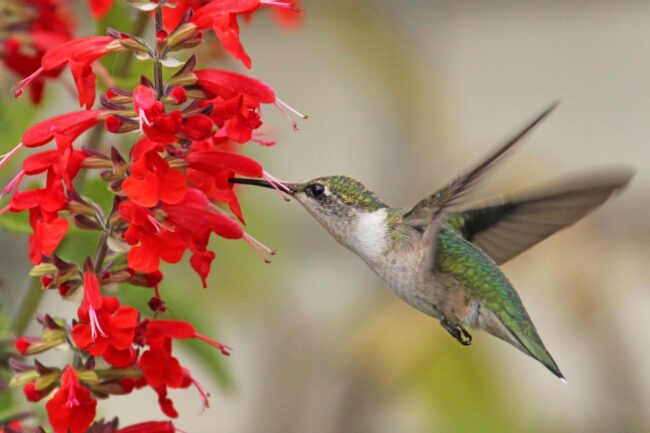The small jewels of the sky and the garden!
The other day I watched a hummingbird hover outside the living room window. He flew up and down, backwards and then off like a shot out of view. I’m not sure what held his interest for that brief moment, but his presence made me feel slightly guilty since I haven’t yet hung up the hummingbird feeder.
Our visitor was the ruby-throated hummingbird. The male has an emerald green back, a white breast and, of course, a ruby-red throat. The female looks similar except she lacks the red throat patch. The ruby-throated hummingbird is one of the smallest birds in North America. It measures just over three inches in length and weighs but a whisper (about one-tenth of an ounce).
There is just something special about seeing a hummingbird. I think it is partly due to the incredible speed at which they move. They can fly at top speed and then stop on a dime. Hummingbirds can appear to remain motionless in midair but know that they are furiously beating their wings. The ruby-throated hummingbird can beat its wings about 53 times a second. Plus, it’s fun to watch how precisely they maneuver. They can fly up, down, sideways, and backwards.
The main food for the ruby-throated hummingbird is nectar. They are most attracted to flowers that fall within shades of red or orange and that are tubular in shape. However, this does not mean that you won’t find them visiting other types of flowers. The best way to attract hummingbirds to your yard is by offering them an assortment of flowers that bloom at different times. This will keep the hummingbirds interested all season long (for ideas on plantings for hummingbirds, see Hummingbirds in the Garden, https://hort.extension.wisc.edu/articles/hummingbirds-in-the-garden/).
Ruby-throated hummingbirds also supplement their diet with small insects such as spiders, mosquitoes, gnats, and small bees. Fortunately for us gardeners, they are even known to eat aphids off leaves.
If you have a yard like mine with limited flowers, you can also hang a feeder to encourage hummingbird visits.
According to Audubon (https://www.audubon.org/community-science/hummingbirds/how-create-hummingbird-friendly-yard):
- hang several feeders far enough apart that the hummingbirds cannot see one another (this will prevent one bird from dominating the rest)
- fill feeders with sugar water made by combining four parts boiling water to one-part white sugar (boil water for one to two minutes and let sugar solution cool before filling the feeder) – never use honey, artificial sweeteners, or red dye.
- hang feeders in the shade to help prevent the sugar solution from fermenting
- change the sugar water regularly before it gets cloudy, or about twice a week in warm weather
- clean feeders with a solution of one-part white vinegar to four parts water about once a week
- if your feeder has become dirty, try adding some grains of dry rice to the vinegar solution and shake vigorously
- rinse your feeder well with warm water three times before refilling with sugar solution
change the sugar water regularly before it gets cloudy, or about twice a week in warm weather
The ruby-throated hummingbird will come in the spring and stay to nest. By late summer / fall, they will start their journey back to tropical areas in Mexico, or Central America. While here, the ruby-throated hummingbird will need to bulk up for its long flight south. They often will double their body weight preparing for the trip. I guess I should get that hummingbird feeder filled and placed in a tree safely away from any neighborhood cats.
Other information on the ruby-throated hummingbird, was provided by the Cornel Lab of Ornithology online bird guide, All About Birds at https://www.allaboutbirds.org/guide/Ruby-throated_Hummingbird.

Photo Credit: Susan Mahr, UW Madison Division of Extension





